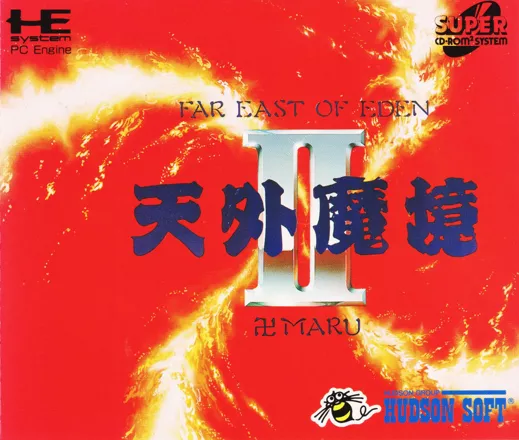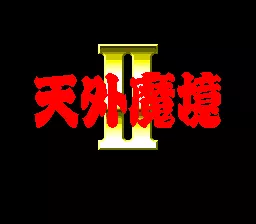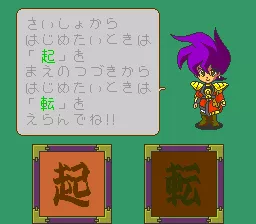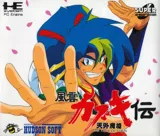Tengai Makyō II: Manjimaru
-
 Tengai Makyō II: Manjimaru
(2003 on
GameCube,
PlayStation 2)
Tengai Makyō II: Manjimaru
(2003 on
GameCube,
PlayStation 2)
Description
Many years ago, the legendary warriors of the Fire Clan were expelled from the Garden of Eden, and built the wonderful land Jipang. Thousand years later, Jipang is entering its medieval era. It seems that the province Hida is suffering from a curse placed upon it by the evil clan of the Dark Orchids. To destroy the Orchids, a young boy named Manjimaru has to fight the demons who protect them, find companions who would help him on the quest, and prove he is worthy of his great legacy as the descendant of the Fire Clan.
Tengai Makyō II: Manjimaru is a sequel to Tengai Makyō: Ziria. Though not connected to its predecessor directly story-wise, the game is set in the same semi-humorous rendition of feudal Japan, and shares many recurrent gameplay-related and stylistic elements. The player navigates a party of up to four characters on a vast overworld divided into provinces, each with its own capital city and several smaller towns. Randomly encountered enemies are fought in turn-based, first-person view combat. Like in the previous game, magic spells must be obtained by locating Tengu Retreats; they can be then equipped on any character and swapped between them.
Enemy hit points are displayed during battles, and characters are restored to full health when leveling up. Full-screen anime-style cutscenes with voiceovers advance the story. As opposed to the previous game, Manjimaru has several audio music tracks in addition to synthesized ones.
Spellings
- 天外魔境2 万字丸 - Chinese spelling (simplified)
- 天外魔境Ⅱ・卍MARU - Japanese spelling
Groups +
Screenshots
Promos
Credits (TurboGrafx CD version)
220 People (210 developers, 10 thanks) · View all
| Original Novel |
|
| Producer | |
| Concept Planner | |
| Game Designer | |
| Lead Programmer | |
| Character Design | |
| Music | |
| Production Director (製作/総指揮) |
|
| Conceptual Work (原作) |
|
| Planner (企画) |
|
| Supervisor (監修) |
|
| Director (総監督) |
|
| Voice Director (演出) |
|
| Manjimaru Sengoku (戦国 卍丸) |
|
| Danjūrō Kabuki (カブキ団十郎) |
|
| Tarō Gokuraku (極楽 太郎) |
|
| Kinu (絹) |
|
| Hoteimaru (ホテイ丸) |
|
| Hanabi (花火) |
|
| Matsuri (まつり) |
|
| Mikoshi (みこし) |
|
| [ full credits ] | |
Reviews
Critics
Average score: 70% (based on 1 ratings)
Players
Average score: 4.5 out of 5 (based on 6 ratings with 0 reviews)
Be the first to review this game!
Trivia
The swastika sign on the game cover has nothing to do with the Nazis (who simply used this very ancient symbol for their purposes). Swastika was a holy symbol in India, and came to Japan via China together with the Buddhist religion. In Japanese this sign is called manji, and is part of the name of the game's hero, Manjimaru.
Analytics
Upgrade to MobyPro to view research rankings!
Identifiers +
Contribute
Are you familiar with this game? Help document and preserve this entry in video game history! If your contribution is approved, you will earn points and be credited as a contributor.
Contributors to this Entry
Game added by Unicorn Lynx.
PlayStation 3, PS Vita, PSP added by Charly2.0.
Additional contributors: Игги Друге.
Game added December 20, 2004. Last modified July 25, 2024.


















